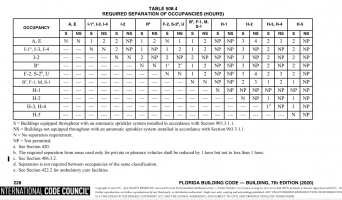Scott F
Registered User
We are currently in the process of preparing permit documents for a new metal building intended for business use, non-sprinklered. The building will serve as a work office (primary purpose) for a General Contractor. The front 1/3rd of the facility will be dedicated to open office space, while the remaining area will be used for general storage. The Florida Building Code, specifically Table 508.4, states that there should be no separation required between Business and S1 or S2 Storage. However, according to NFPA Table 6.1.14.4.1(b), it is necessary to have a 2-hour separation between the two spaces. Before presenting this situation to our local building officials, I would like to receive input from the community on this matter. The floor plan is attached for reference.

